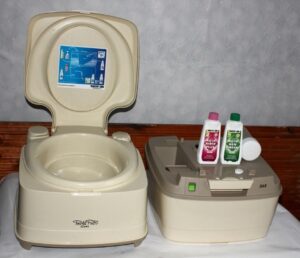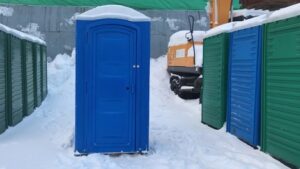Types of dry closets: how to choose the right one for a construction site
Types of dry closets are represented mainly by chemical and electric ones. Moreover, among the former, several subtypes are distinguished depending on what liquid is used for disinfection. You can choose almost any model for a construction site, but the most effective is a chemical toilet. Why this is so is discussed in detail in the article.
The content of the article
Chemical toilets
These are self-contained toilets that do not require an electrical connection, liquid drainage, or ventilation installation. They have several advantages:
- hygiene;
- complete sealing of the room;
- no odors;
- simple maintenance.
The chemical toilet for the construction site is represented by 2 containers. The top one is completely filled with water; waste is drained with its help. It is equipped with a pump, which can be electric, piston or bellows. The lower container receives waste products.

This type of toilet is called a liquid toilet because a chemical in liquid form is used for sanitization:
- A solution of formaldehyde (formalin) destroys all bacteria, fungi and other pathogenic microorganisms. The liquid has a bluish tint, and it can only be drained into a public sewer.
- Ammonium compounds are not as toxic, although they do not decompose waste products as quickly as formaldehyde. The color of the liquid is green.
- Biological solutions with bacterial strains or enzymes. This is the most environmentally friendly option, since the composition is completely safe for the environment. But such a dry closet is used less frequently on a construction site, since the fluid has to be replaced several times a day.
As a rule, chemical toilets with formalin are used for construction. This is the most effective remedy that suppresses the processes of decay and bacterial growth. Therefore, the room does not smell of anything and can be used for a long time without treating the container.
Electric dry toilets
You can also consider an electric dry closet for construction sites. Unlike a chemical device, this device burns or dries waste products. Moreover, the treatment takes place at a fairly high temperature - more than 500 ° C. For this, such a toilet is equipped with an electric heater, the power of which reaches 1.5 kW.
The full processing cycle takes 20-40 minutes, and some time is also spent heating the elements to the desired temperature. Total energy consumption for one visit does not exceed 1.5 kWh. This is not a huge expense, but chemical toilets are more cost effective.

Which toilet to choose
If you choose a toilet for a construction site, it is better to choose a chemical one that uses a formaldehyde solution. This is the most economical and at the same time the most effective option.

As for biological fluid or a solution of ammonium compounds, such devices are most often purchased by summer residents. After processing, they use the waste to make compost and add fertilizer for digging. But at a construction site there is no such need, so it is worth considering formaldehyde liquid. You can also install an electric toilet, but then utility costs will increase somewhat.





